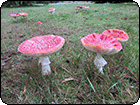AskMecha: Probability question follows →[More:]I suck at maths and anything associated. I need to work out the probability of something because of a stupid situation at work where someone is claiming that they have been singled out and are quoting preposterous probability figures to 'prove' it.
If I start with a pool of 1,473 and take a sample from that pool of 35, obviously the odds of any one of that pool being selected is 1/1,473. If I then select a second sample, the odds would be 1/1,472, right? What are the odds of two specific samples being selected out of the pool of 1,473, though? Bonus points for showing me how I should calculate that.
 photo by splunge
photo by splunge
 photo by TheophileEscargot
photo by TheophileEscargot
 photo by Kronos_to_Earth
photo by Kronos_to_Earth
 photo by ethylene
photo by ethylene